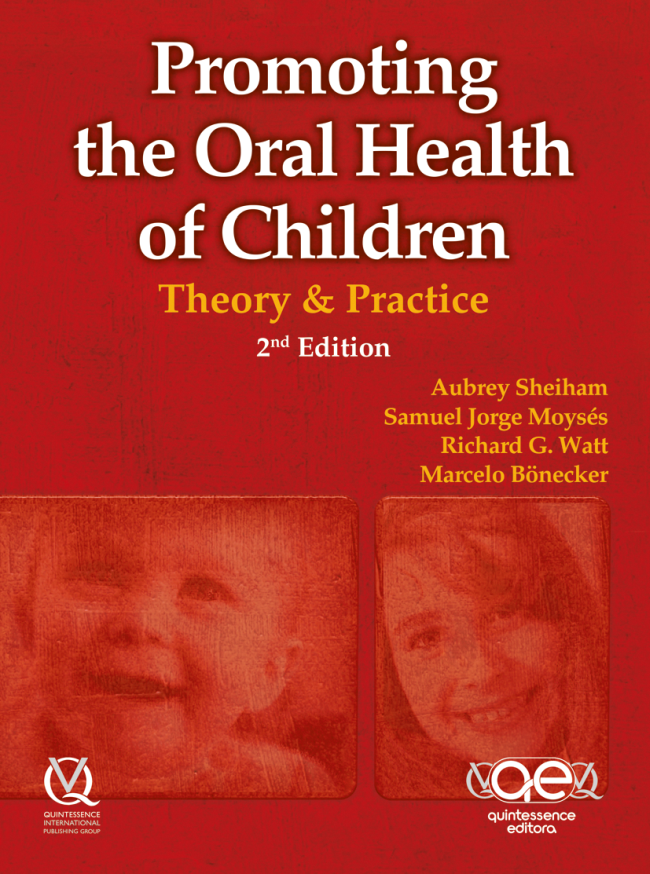Oral Health and Preventive Dentistry, 4/2012
DOI: 10.3290/j.ohpd.a28902, PubMed-ID: 23301232Seiten: 319-326, Sprache: EnglischAbanto, Jenny / Rezende, Karla Mayra Pinto e Carvalho / Carvalho, Thiago Saads / Correa, Fernanda Nahas Pires / Vilela, Tamara / Bönecker, Marcelo / Salete, Maria / Correa, Nahas PiresPurpose: To assess the effectiveness of tooth wipes in removing dental biofilm from babies' anterior teeth, as well as to evaluate the babies' behaviour and the guardians' preference concerning hygiene methods.
Materials and Methods: In this random blind cross-over study, 50 high caries risk babies, from 8 to 15 months old, were divided into two groups: babies with oral hygiene performed by caregivers (n = 25) or by their mothers (n = 25). The caregivers and mothers removed biofilm using three methods of oral hygiene (tooth wipes, toothbrushes and gauze), one in each experimental phase. Professional cleaning was done before each phase, which had 2 days of biofilm accumulation and 1 experimental day, when caregivers and mothers used one method to remove biofilm. Examiners blinded to the study design assessed the biofilm index at baseline, prior to and following biofilm removal using each method. The babies' behaviour and the mothers'/caregivers' preference were assessed.
Results: The tooth wipes, toothbrushes and gauze significantly reduced the amount of biofilm (P 0.001). The mothers' group removed more biofilm than the caregivers' group, using toothbrushes or tooth wipes (P 0.05). Babies in the mothers' group had better behaviour using tooth wipes than toothbrushes (P 0.05). Mothers and caregivers preferred to use tooth wipes.
Conclusions: Tooth wipes are effective in removing biofilm from babies' anterior teeth and are the method best accepted by mothers, caregivers and babies.
Schlagwörter: babies, dental biofilm, hygiene methods
Quintessence International, 7/2009
PubMed-ID: 19626229Seiten: 553-558, Sprache: EnglischBönecker, Marcelo / Mantesso, Andrea / de Araújo, Ney Soares / Araújo, Vera CavalcantiObjectives: To analyze the expression of tenascin, fibronectin, collagens I and III, osteonectin, and bone morphogenetic protein 4 (BMP4) in the extracellular matrix of pulp tissue in primary teeth during physiologic root resorption.
Method and Materials: Eighteen teeth were decalcified and equally distributed into 3 groups (group I, teeth with two-thirds root length; group II, teeth with one-third root length; and group III, teeth lacking the root).
Results: Immunohistochemical analysis showed that all the proteins were expressed. Tenascin, collagen I, and osteonectin showed strong and broad reactivity in group I, with weaker and rare reactivity in groups II and III. The expression of fibronectin, collagen III, and BMP4 did not vary with root resorption phase.
Conclusion: The expression of tenascin, collagen I, and osteonectin was reduced in the extracellular matrix and odontoblasts during root resorption. This fact may be related to the decreasing pulp response to damage and treatment during the progression of root resorption.
Schlagwörter: dentin matrix, endodontics, immunohistochemistry, primary teeth, pulp, proteins
Quintessence International, 3/2006
PubMed-ID: 16536146Seiten: 191-197, Sprache: EnglischVolchansky, Alf/Cleaton-Jones, Peter/Drummond, Sian/Bönecker, MarceloObjective: This study was conducted to compare vertical and horizontal periodontal measurements of posterior teeth on standardized panoramic and intraoral radiographs.
Methods and materials: Standardized panoramic and periapical radiographs were made of 16 human skulls using ball bearings placed on the maxillary first molars to allow adjustment for horizontal and vertical magnification.
Results: At 14 of 19 measurement sites there was no significant difference between measurements on the 2 radiographic film types. At 4 sites vertical measurements on panoramic radiographs were significantly larger than on periapical radiographs (0.80 to 1.37 mm). At one site horizontal measurements were significantly greater on periapical radiographs (0.88 mm).
Conclusions: If there is adjustment of the raw data for magnification as suggested in this study, panoramic radiographs may be used for measurement studies in the posterior region once the patients are positioned appropriately within the focal trough of the machines and the magnification range for the posterior focal trough is used for adjustment of data.
Schlagwörter: panoramic radiograph, periapical radiograph, posterior teeth




